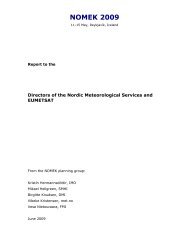International Symposium on Mitigative Measures against Snow ...
International Symposium on Mitigative Measures against Snow ...
International Symposium on Mitigative Measures against Snow ...
Create successful ePaper yourself
Turn your PDF publications into a flip-book with our unique Google optimized e-Paper software.
<str<strong>on</strong>g>Internati<strong>on</strong>al</str<strong>on</strong>g> <str<strong>on</strong>g>Symposium</str<strong>on</strong>g> <strong>on</strong> <strong>Mitigative</strong> <strong>Measures</strong> <strong>against</strong> <strong>Snow</strong> Avalanches<br />
Egilsstaðir, Iceland, March 11–14, 2008<br />
gliding and should be such that irrelevant variati<strong>on</strong>s with height above sea level and aspect of<br />
the slope are not imposed.<br />
In additi<strong>on</strong> to the different c<strong>on</strong>diti<strong>on</strong>s with regard to snow density and gliding, extreme snow<br />
depths in many starting z<strong>on</strong>es in Iceland may be expected to pose serious problems for<br />
supporting structures under Icelandic c<strong>on</strong>diti<strong>on</strong>s. As a c<strong>on</strong>sequence of frequent snow drift in<br />
the windy Icelandic climate, snow depth in starting z<strong>on</strong>es is often quite variable. The snow<br />
preferentially accumulates in depressi<strong>on</strong>s and gullies, where vertical snow heights in excess of<br />
6 m are comm<strong>on</strong>, even in average winters, whereas the snow depth <strong>on</strong> ridges and c<strong>on</strong>cave<br />
parts of the starting z<strong>on</strong>es remains low throughout the winter. One may expect that supporting<br />
structures are impractical due to extreme snow depths in many important starting z<strong>on</strong>es above<br />
inhabited areas in Iceland due to this reas<strong>on</strong>. This problem is not unique to Iceland, as similar<br />
problems are also encountered in high altitude avalanche starting z<strong>on</strong>es in Alpine countries.<br />
In spite of these problems, it is clear that supporting structures are a viable avalanche<br />
protecti<strong>on</strong> for several avalanche pr<strong>on</strong>e areas in Icelandic villages, especially where c<strong>on</strong>diti<strong>on</strong>s<br />
are unfavourable for other protecti<strong>on</strong> methods and where extreme snow depths in depressi<strong>on</strong>s<br />
and gullies are not expected. The goal of the pilot experiment was to expose several types of<br />
commercially available structures from Alpine countries to Icelandic c<strong>on</strong>diti<strong>on</strong>s, measure key<br />
quantities related to the loading of the structures, investigate corrosi<strong>on</strong> of the structures under<br />
the highly corrosive maritime c<strong>on</strong>diti<strong>on</strong>s typical for Icelandic starting areas and test<br />
traditi<strong>on</strong>al drilling and anchoring methods in Icelandic bedrock and loose materials, which are<br />
of volcanic origin and have different properties compared with hillsides in typical Alpine<br />
starting areas.<br />
2. THE TEST AREA: LAYOUT AND GENERAL OBSERVATIONS<br />
The supporting structures are located at 490−530 m a.s.l. in Grindagil in the mountain Hafnarfjall<br />
west of the village of Siglufjörður. They have Dk in the range 3 to 5 m and are arranged<br />
in four rows labelled I, II, III and IV from above (Figure 1, Table 1).<br />
Table 1: Rows of supporting structures in Grindagil in Siglufjörður.<br />
Row Type Producer Length<br />
(m)<br />
Number<br />
of posts<br />
Height<br />
Dk (m)<br />
Cost<br />
(kIKR/m)<br />
I and IV bridges J. Martin 110 38=24+14 3−5 161<br />
II nets Geobrugg 50 14 3−4 156<br />
III nets EI 41.5 15 3−5 158<br />
The structures were installed during a five week period in the autumn of 1996 (Hopf, 1996).<br />
A separate account was kept of the cost of the structures and installati<strong>on</strong> work for each type of<br />
structures. The average cost per m for each type of structures was similar as tabulated in the<br />
last column in Table 1 in Icelandic kr<strong>on</strong>as at the 1996 price level. All the supporting<br />
structures were hot-dip galvanised, as is generally the rule for out-door steel structures in<br />
Iceland. This led to a relative increase in the price of the steel bridges compared with Alpine<br />
prices as steel bridges are typically not galvanised in Alpine countries.<br />
144 Supporting structures under Icelandic c<strong>on</strong>diti<strong>on</strong>s











